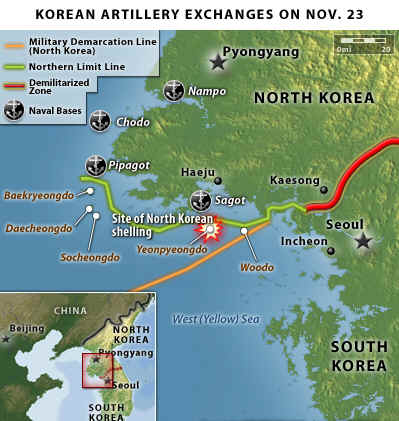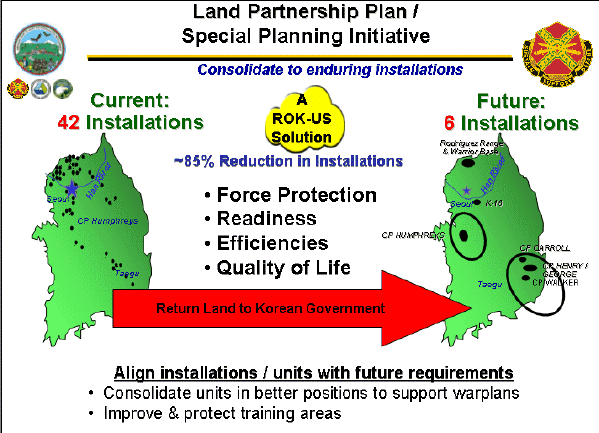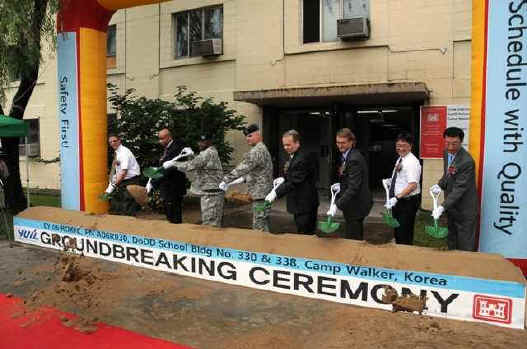In February 2011, Secretary of Defense Robert Gates said
that any future defense secretary who advises the president to again send an American land army into Asia or into the Middle East or Africa should "have
his head examined", echoing General Douglas MacArthur's 1964 warning about
sending American combat troops to Vietnam. Given that logic, someone should ask why we keep 20,000 American soldiers in the middle of a potential Asian shooting gallery --
Korea. Friction between North and South Korea are obvious, but tensions between Japan and South Korea remain, and China and Japan quarrel. Cultural conflicts
have existed for centuries, hard feelings remain from World War II, and a
scramble for offshore oil causes diplomatic squabbles over tiny islands. 
American military bases in South Korea ensure the USA will be drawn into any petty spat that leads to war among regional powers, in which the USA has no interest. For example, South Korea's new president likes to match North Korea's aggressive attitude, which resulted in two deadly confrontations in 2010. While the American media reported on the grave danger these clashes presented, they rarely showed maps that illustrate these incidents were the result of provocative South Korean military training exercises just off the North Korean coast. If Korean games lead to war, the USA should not become involved in the fighting.
The presence of American bases is a source of conflict too. Most South Koreans want them closed because North Korea has long maintained that the withdrawal of all foreign forces from the Korean peninsula is a prerequisite for peace. There are no Chinese or Russian forces in North Korea, even though South Korea is far stronger. It has twice the population, 50 times the economic power, and a modern military that is roughly five times stronger than the rag tag North Korean Army.
According to the January 1, 2011 issue of the "Economist", as late as 1975 North Korean income per person exceeded that of South Korea. By 2009, North Koreans earned just $960 per year, while South Koreans averaged $19,200 each, and there are twice as many South Koreans as North Koreans! South Korean industrial production exceeds that of Russia, and China has become its major trading partner. South Korea's Hyundai and the South Korea Land Corporation run the Kaesong Industrial Complex a few miles inside the North. It hosts 116 factories employing 40,000 North Koreans. Some $20 million of these goods are shipped across the DMZ into South Korea every day along a joint rail line that also carries goods from South Korea to China and Russia.
As a result, a second Korean war is highly unlikely, and if it did erupt, South Korea could easily win without any help from the USA. Therefore, a bold American President should order all American troops out of South Korea to save billions of dollars a year, which the U.S. Army can invest in new equipment, and free enough base manpower to form another combat division. Unfortunately, such a proposal would result in screams of betrayal from traditionalist American Generals and major corporations that benefit from the long-standing North Korean threat business.
 Several years ago, brash Secretary of
Defense Donald Rumsfeld challenged this outdated arrangement. He forced some
change by withdrawing one combat brigade and consolidating bases, but only after
agreeing to billions of dollars for new spending. South Korea paid some of
this cost, yet U.S. taxpayers have spent $13 billion to implement an
ultra-expensive scheme called the "Land Partnership Plan." American
troops will be withdrawn from 42 smaller camps into six large, modern bases.
Meanwhile, South Korea has slashed military spending to devote more resources
for economic development and devotes far less of its GDP to defense than does
the USA.
Several years ago, brash Secretary of
Defense Donald Rumsfeld challenged this outdated arrangement. He forced some
change by withdrawing one combat brigade and consolidating bases, but only after
agreeing to billions of dollars for new spending. South Korea paid some of
this cost, yet U.S. taxpayers have spent $13 billion to implement an
ultra-expensive scheme called the "Land Partnership Plan." American
troops will be withdrawn from 42 smaller camps into six large, modern bases.
Meanwhile, South Korea has slashed military spending to devote more resources
for economic development and devotes far less of its GDP to defense than does
the USA.
Few Americans understand the enormous overhead inherent in our modern military bases. In most cases, the actual military "tenant units" for whom the base exists represent a small fraction of a military base's total population. Bases have a headquarters, shopping malls, restaurants, gyms, schools, and clubs. For example, the Army's new multi-billion dollar Camp Humphreys base near Seoul (below) will eventually have a population of 60,000 Americans, to include only 17,000 uniformed soldiers, and only 8000 are combat troops! If Korea is truly a dangerous place, why is the U.S. Army expanding the number of resident military family members to 30,000, all living within artillery range of the DMZ?
Deactivate 8th Army Headquarters
Pulling all American troops out of Korea is reasonable, but may prove politically difficult with the dozens of South Korean paid lobbyists in Washington DC working to protect "their" bases and the resulting jobs and profits. Army combat forces are to be consolidated at Camp Humphreys just south of Seoul, consisting of an armored brigade, artillery brigade, and aviation brigade. These 8000 GIs are token combat forces compared to the massive, modern South Korean Army that instantly grows to a 5,000,000 man force upon mobilization. The three U.S. Army brigades represent just half of the 2nd Infantry Division, which is all that remains of the once mighty U.S. 8th Army.
 In the U.S. Army's traditional triangular structure, a field
Army headquarters commands three Corps, which each command three combat
Divisions. During the Korean war, 8th Army Headquarters commanded
hundreds of thousands of GIs. As combat troop levels fell over the years, 8th
Army remained since it would also command all South Korean units during wartime.
However, pressure from South Korean voters recently forced change so that South Korean Generals
command during hostilities, yet the huge 8th Army headquarters complex
remains with a dozen Generals and a platoon of Colonels to command just three brigades! Under its triangular structure, a field army headquarters should
command roughly: 3 corps x 3 divisions x 5 brigades = 45 brigades, yet 8th Army
commands just 3 combat brigades!
In the U.S. Army's traditional triangular structure, a field
Army headquarters commands three Corps, which each command three combat
Divisions. During the Korean war, 8th Army Headquarters commanded
hundreds of thousands of GIs. As combat troop levels fell over the years, 8th
Army remained since it would also command all South Korean units during wartime.
However, pressure from South Korean voters recently forced change so that South Korean Generals
command during hostilities, yet the huge 8th Army headquarters complex
remains with a dozen Generals and a platoon of Colonels to command just three brigades! Under its triangular structure, a field army headquarters should
command roughly: 3 corps x 3 divisions x 5 brigades = 45 brigades, yet 8th Army
commands just 3 combat brigades!
The spin is that 8th Army will command dozens more American combat brigades after they arrive to repel the invading North Korean army. Yet that concept is no longer valid -- no American reinforcements are required! Some Generals now argue that 8th Army along with its 19th Sustainment "logistics" Command provide a command and support team for any contingency in Asia. However, they exist in fixed facilities in Korea with very limited mobility assets. This is why I Corps headquarters in Washington State, with forward elements at Camp Zama, Japan, has long been the U.S. Army's designated Asian contingency force command.
Deactivating 8th Army would provide additional manpower and resources to enhance I Corps capabilities. Moreover, eliminating the 19th Sustainment Command allows the Army to close its four outdated logistics camps located far south from Camp Humphreys in what is called the "Daegu complex", with Camps Henry/Walker/Carroll/George. (circled on the map above) The Army employs some 5000 Americans at these camps, yet only 1400 are soldiers, and none are combat troops. Their traditional role is to serve as staging and support areas for the 100,000+ American soldiers due to arrive should another Korean war erupt. No one thinks that will be necessary, yet this outdated cluster of warehouses remains, maintained by thousands of Koreans employed by the U.S. Army to run an array of expensive base and family support activities.
 One
can browse the USAG
Daegu phonebook to understand the massive support overhead now found
at all American military bases, which require several times more resources than the
operational "tenant units" themselves. Fewer than a thousand GIs are
assigned to 19th Sustainment Command around Daegu, yet their support facilities
include two bowling centers, two libraries, three fitness centers, four swimming
pools, three fire stations, and even a veterinarian clinic and arts and crafts
store! Maintaining these activities on the other side of the world costs far
more than in the USA, while employing thousands of Koreans and providing
billions of dollars in economic stimulus to their economy. The Army is spending
over a billion dollars in Korea for new construction in the Daegu area, to include $8 million to refurbish an old barracks
into a new
high school.
One
can browse the USAG
Daegu phonebook to understand the massive support overhead now found
at all American military bases, which require several times more resources than the
operational "tenant units" themselves. Fewer than a thousand GIs are
assigned to 19th Sustainment Command around Daegu, yet their support facilities
include two bowling centers, two libraries, three fitness centers, four swimming
pools, three fire stations, and even a veterinarian clinic and arts and crafts
store! Maintaining these activities on the other side of the world costs far
more than in the USA, while employing thousands of Koreans and providing
billions of dollars in economic stimulus to their economy. The Army is spending
over a billion dollars in Korea for new construction in the Daegu area, to include $8 million to refurbish an old barracks
into a new
high school.
The three small, regional Army offices around Daegu could move to U.S. Army bases in Japan, or to space vacated by 8th Army headquarters at Camp Humphreys. The Army's 2nd Infantry Division could assume command of U.S. soldiers in South Korea, which could be efficiently consolidated in the Camp Humphreys area. Note that half of that division is located at Fort Lewis in Washington state, so it can easily assume command of any 8th Army assets that must remain in Korea to support these token combat forces. Meanwhile, the U.S. Army would save billions of dollars a year in operating costs and free some 8000 headquarters and support soldiers for reassignment to combat units worldwide. This proposal will be opposed by those who currently profit from the "Korean threat" business, who will decry "dangerous cuts", even though it will not reduce any American combat forces in Korea. Meanwhile, the Army can end its mindless plan to build the largest military warehouse in the world at Camp Carroll to store equipment for American troops who will never arrive to defend South Korea.
Some use great imagination to retain their profitable Korean status quo. Perhaps China will join with North Korea and invade South Korea! But why? South Korea has no natural resources, and an invasion would result in a war with its largest customer, the USA, and probably Japan and Taiwan. China's export driven economy would collapse as it becomes mired in a senseless conquest. Although South Korea is many times more powerful than the North, some suggest that capitalism has made South Koreans soft, so they may not put up a fight. They should recall the logic of President Lyndon Johnson who said in 1964 that he was “not about to send American boys nine or ten thousand miles from home to do what Asian boys ought to be doing themselves.”
If South Koreans are unwilling to defend their nation from poverty stricken cousins from the North, why should Americans defend them? The USA imports no vital resources from Korea; the consumer items imported from South Korea are available elsewhere. In reality, no U.S. troops are needed in South Korea. A bold U.S. President should begin a gradual withdrawal of American military units from Korea to lessen military tensions and promote reunification. The first step is to deactivate the outdated command and support troops of the 8th Army and close the Daegu complex.
Carlton Meyer editorG2mil@Gmail.com
©2011 www.G2mil.com